When you’re just starting out in the realm of towing, there are a lot of things that can be quite complicated.
One such discussed complication is the weight distribution hitch vs sway bars debate.
People who are new to towing frequently have the misconception that these things are fundamentally the same.
In reality, they have different functions and working capacities.
Let’s discuss the difference between them today.
Weight distribution hitch vs sway bars: what differentiates them?
In the simplest terms, sway bars do the job of reducing wobble or sway while weight distribution hitches shift the vehicle’s center of gravity from the back to the front axle.
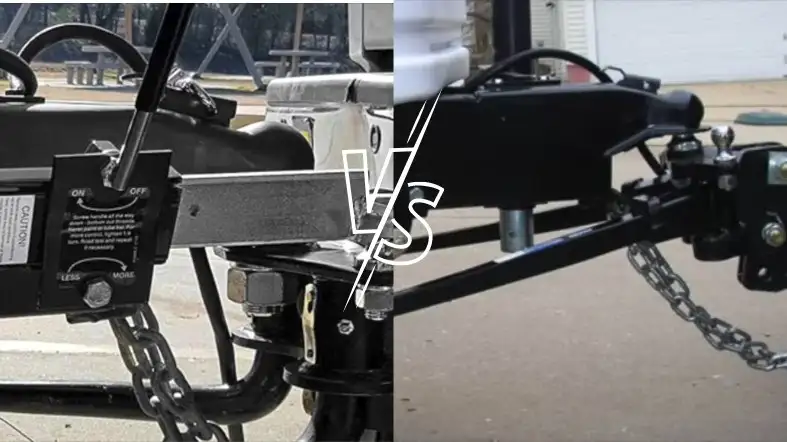
Though both are fundamentally distinct, each one works toward the same aim of improving trailering conditions.
The Weight Distribution Hitch: what is it and what purposes does it serve?
Ever heard about the special hitch on a truck?
The weight distribution hitch is simply this special hitch that seats the truck.
It has dual chains or sophisticated bars.
Connection to the trailer’s front:
The chains or bars run from the trailer’s front end to the middle of the hitch to make the connection secure.
They connect the towing trailer’s front end and hitch.
So, these bars or chains connect to your truck in a manner that ensures the distribution of the weight of the trailer more evenly.
Even weight distribution:
Put in another way, both the axles on the truck shall have the same quantity of weight.
The weight distribution hitch balances the weight between the rear and front axles.
Consequently, there is way less pressure on the truck’s back end.
It prevents sag or excessive squats:
Well, this is how you will know if the hitch is functioning properly.
When you connect your trailer to your vehicle using a weight-distribution hitch, look carefully at the truck’s back end.
If the hitch gets to work efficiently, you will notice little to no sag or stoop at the truck’s back end.
This on one end makes the experience of towing smoother and much more uniform.
Also, it minimizes the likelihood that your towing vehicle will sustain damage.
The Sway Bars: What Is It And What Purposes Does It Serve?
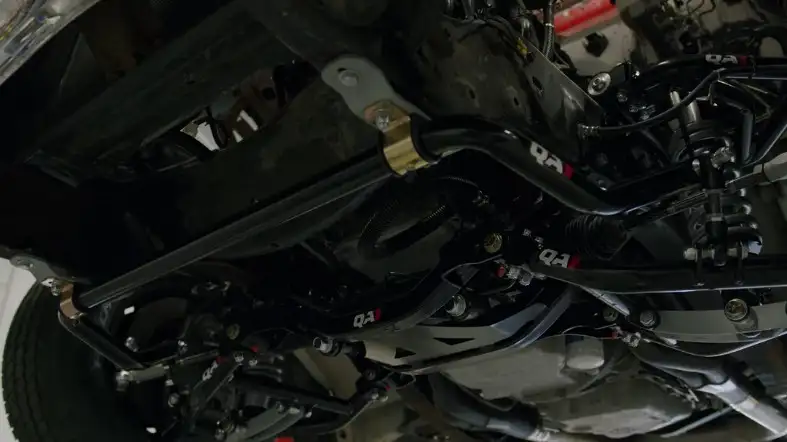
Sway controllers or sway bars are bars that link the tongue of the towing trailer and the hitch in use.
So, it looks like they do the same work.
But, fundamentally, the pulls of different stuns.
These bars often have steel or other metal bodies to reinforce the lading capacity and performance.
They don’t distribute weight:
These bars do not distribute the weight of the trailer or RV evenly across your towing vehicle because that is not their purpose.
They simply reduce the sway.
They minimize the sway:
When we travel down the road, a sway bar can prevent the RV or trailer from rocking back and forth.
Thus, it allows the weight distribution hitch to do its job well.
The majority of vehicles that use sway bars are pickup trucks.
These trucks usually have a ball hitch in the rear bumper and are pulling large trailers or recreational vehicles or RVs.
When going at high speeds, there will always be some wiggle room for the trailer.
No matter how tightly the coupler on the trailer connects to the hitch ball, you cannot prevent the sway.
In fact, when a strong wind blows against the side of the trailer, this might also cause it to sway.
Then, how to deal with it?
Here come the sway bars.
Sway bars are intended to help prevent the trailer from moving too much in one direction or the other.
After that, the hitch has to do the rest of the job by distributing the weight and reducing the pressure.
The Differences: Weight Distribution Hitch Vs Sway Bars
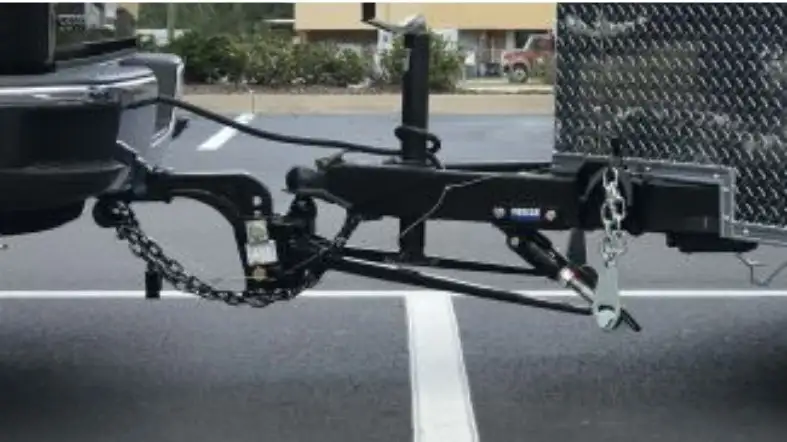
First off, the first sight of sway bars won’t tell you much about the different functions they do when compared to the weight distribution hitches.
But, when we dive into it, we see how they are fundamentally different.
Here are the major differences between these two pieces of equipment.
Chains vs bars:
It is very frequent that there will be chains or bars in the weight distribution hitch.
There are only a few types of hitch that don’t use chains.
These bars or chains attach the weight distribution hitch from the trailer to the vehicle that is doing the pulling.
But the sway control system doesn’t work this way.
There is no place for any chain.
Rather, it has solid metal bars, such as steel bars.
The bars connect the truck via the hitch to the trailer. Thus, it prevents sway.
Preventing sway:
The capabilities of the two systems are where the primary distinction lies between them.
When it comes to effectively preventing sway, the hitch is of no use.
It all depends on the sway bars at this point.
On the other hand, sway bars are completely ineffective when it comes to distributing weight evenly across the entirety of your towing vehicle.
There is a direct consequence of this as well.
There generates a tongue mass while towing.
The majority of that mass will only fall back on the bumper of the vehicle that you use for towing.
When pulling lighter campers and trailers, this isn’t a big deal.
But what about towing heavier trailers?
Then, it can be problematic.
So, we need the weight distribution hitch.
Thus, both do different jobs to ensure a smooth towing experience.
Weight Distribution Hitches With Sway Bars:
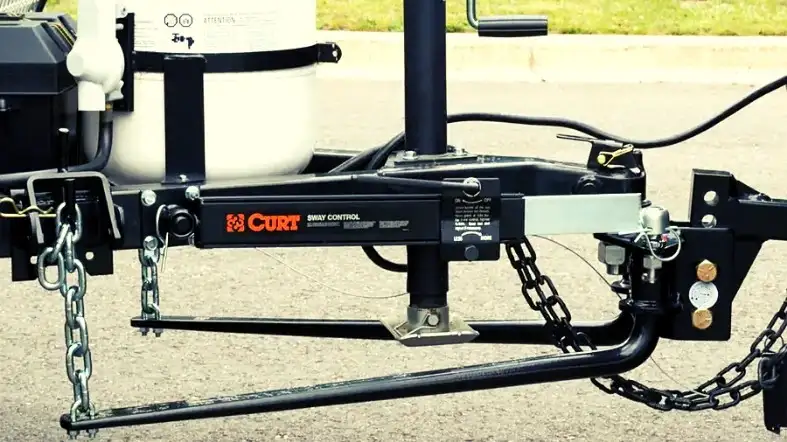
Weight distribution hitches don’t usually control sway.
However, luckily, a few of them also manage the vehicle’s sway while also distributing its weight.
Both functions can be accomplished by hitches that use metal bars rather than chains to make the connection between the truck and the trailer.
In this way, on the one hand, they can prevent your trailer from wobbling.
On the other hand, they distribute weight uniformly across the hitch, on the rear axles, and likewise on the front axles.
Leveling the trailer tongue:
A weight distribution hitch moves weight around your towing vehicle in a manner that is both even and consistent.
So, it relieves a significant amount of stress from the trailer hitch.
For instance, if you do not use weight distribution on a car and then link a trailer to it, the back end of the truck will be in trouble.
It will sink down immediately.
When a weight-distribution hitch is in place, on the other hand, the vehicle’s rear end maintains its level position and does not collapse.
This results in a more comfortable and secure experience when you are towing.
It also assures that your front and rear tires will have an equal degree of traction.
Mandatory Vs Not Mandatory:
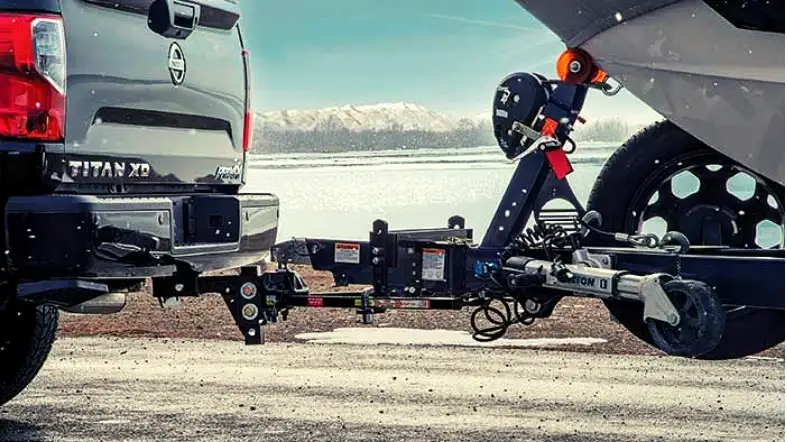
Yes, you have read it right.
No matter what we have discussed earlier, you don’t really have to buy a sway bar as mandatory.
It is something that you can rather choose not to buy.
They are not obligatory in any way and serve no purpose other than to be an addition to the hitch.
They can only make your journey more comfortable and secure.
So, the law does not compel their use.
On the other hand, weight distribution hitches may be obligatory even by the laws.
It all depends on the dimensions of both your towing vehicle and the load you intend to transport.
Most people agree that you need a weight-distribution hitch if the stuff you’re towing weighs more than half as much as the vehicle you’re using to pull it.
Let’s say you want to pull a recreational vehicle or trailer weighing 2,500 pounds behind a 4,000-pound vehicle.
Here you will need a weight-distribution hitch in order to safely pull it.
A weight distribution system is preferable to towing without one even if your local laws don’t necessitate it.
Maneuverability:
Reverse maneuvering is impossible with sway control bars.
Weight distribution hitches may be more maneuverable depending on the type.
The chains allow the hitches to maneuver.
FAQs about weight distribution hitch vs sway bars
Do I Need A Sway Bar If I Have A Weight Distribution Hitch?
As they do different jobs, it is safe to have both to them.
However, you can skip the sway bars as we have discussed earlier.
Does Weight Distribution Help With Sway?
It will help with sway if it comes with an incorporated sway.
Do Sway Bars Make A Difference In Towing?
Sway control or sway bars are camper or hitch accessories that prevent sway.
Sway bars aren’t necessary.
But they make towing safer and more comfortable with peace of mind.
How Do I Know If I Need A Weight Distribution Hitch?
You will need it if the weight of what you are towing exceeds the weight of your vehicle by more than half
Final Words:
The weight distribution hitch vs sway bars debate is significant to get into and we have done it throughout the article.
Now you know the differences between sway bars and weight distribution hitches, as well as an explanation of why these distinctions are significant.
You might need to have either one of these components fitted or both of them based on the car you’re towing and what you’re pulling behind it.
So, make your move prudently.
